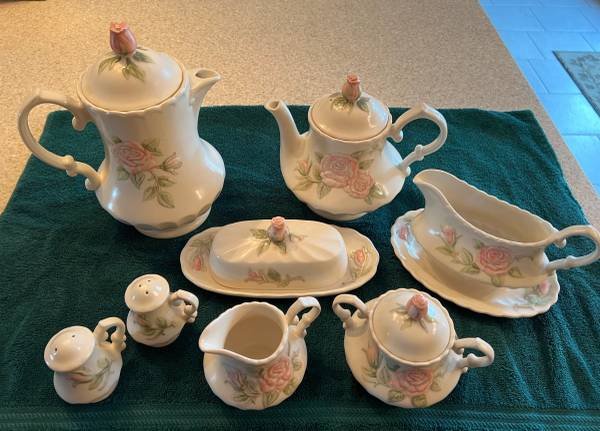Metlox Pottery is an iconic name in American ceramic history, particularly known for its vibrant, durable, and beautifully designed dinnerware. One of its most beloved collections is the California Rose Pattern from the Vernon Ware series. In this blog post, we’ll dive into the history of Metlox dining California Rose pattern Vernon Ware, exploring how it became a household favorite in mid-century America and why it continues to charm collectors today.
Introduction: A Classic American Dinnerware
Imagine setting your table with warm, sun-kissed dishes adorned with cheerful pink roses. That’s exactly what the California Rose Pattern from Metlox’s Vernon Ware line evoked—a sense of comfort, warmth, and timeless beauty. Introduced during a time when colorful and sturdy ceramics were in high demand, this particular pattern found a special place in American homes.
In this post, we’ll explore the backstory of Metlox Pottery, how the California Rose Pattern became a standout, and why collectors still treasure it today. Let’s step back in time and take a look at the fascinating history of this much-loved dinnerware.
1. The Birth of Metlox Pottery: A Californian Gem
Founded in Manhattan Beach, California, in 1927 by T.C. Prouty, Metlox Pottery initially specialized in manufacturing outdoor ceramic signs. It wasn’t until the 1930s that the company pivoted towards dinnerware, a move that would cement its legacy in American homes.
The company thrived during the mid-20th century, tapping into the post-World War II ceramic boom. By creating durable, colorful pieces that felt like a breath of fresh Californian air, Metlox became synonymous with everyday elegance. The company, under the leadership of Prouty’s son Willis, introduced several popular lines, including Vernon Kilns—which was eventually rebranded as Vernon Ware after Metlox acquired it in 1942.
2. The Vernon Ware Line: Bold, Stylish, and Timeless
The Vernon Ware line was all about practicality, durability, and style. Metlox worked to design everyday dining pieces that could withstand regular use without sacrificing aesthetic appeal. Vernon Ware, with its hand-painted designs and attention to detail, fit right into the postwar boom when families wanted dinnerware that matched their bright, modern kitchens.
Of all the Vernon Ware patterns, the California Rose Pattern stood out for its distinct charm and nostalgic beauty. Produced from the late 1940s through the 1960s, this pattern featured delicate pink roses blooming on vines with soft green leaves, all set against a creamy white backdrop. It was feminine without being overly floral, and it evoked the romantic essence of California gardens.
3. The California Rose Pattern: A Post-War Favorite
The California Rose Pattern became a favorite in postwar America for a reason—it reflected the optimism and warmth of the era. After years of war and economic uncertainty, American households were looking for products that symbolized peace, comfort, and prosperity. The soft, pastel colors of the California Rose design felt hopeful and inviting, making it a popular choice for newlyweds and families alike.
The pieces in this collection—plates, bowls, cups, and saucers—were not only beautiful but also functional. The hand-painted roses made each item feel special, adding a touch of elegance to everyday meals. Whether used for Sunday family dinners or casual breakfast get-togethers, the California Rose Pattern brightened up the table and made meals feel a bit more special.
4. Metlox’s Decline and the Legacy of Vernon Ware
Unfortunately, despite its popularity, Metlox Pottery began to decline in the 1970s as the demand for handmade ceramics slowed, and cheaper alternatives flooded the market. By the late 1980s, Metlox had closed its doors for good, leaving behind a legacy of cherished American dinnerware.
But while the factory may have shut down, the demand for Metlox’s Vernon Ware—especially the California Rose Pattern—never faded. Today, collectors seek out these mid-century pieces at flea markets, estate sales, and online auctions. California Rose pieces, with their timeless appeal, continue to be one of the most sought-after patterns in vintage dinnerware.
5. Why Collectors Love the California Rose Pattern
What makes the California Rose Pattern so special to collectors? For one, it embodies the essence of mid-century American ceramics—bright, durable, and undeniably charming. The pieces are versatile, fitting into both vintage and modern homes. Their quality also means they’ve stood the test of time, with many still in use today.
Additionally, there’s a nostalgia factor at play. For many collectors, these dishes remind them of family gatherings or grandparent’s homes. The rose pattern is more than just a design—it’s a memory.
Conclusion: A Rose that Never Fades
The history of Metlox dining California Rose pattern Vernon Ware is one filled with innovation, beauty, and a touch of nostalgia. Though Metlox Pottery no longer produces its famous dinnerware, the California Rose Pattern lives on in the homes of collectors and enthusiasts, a testament to the lasting appeal of well-made, beautifully designed pieces. Whether you’re a longtime collector or someone new to the world of vintage ceramics, the California Rose Pattern offers a glimpse into a golden era of American dinnerware.
FAQs
1. When was the California Rose Pattern produced?
The California Rose Pattern was produced by Metlox as part of its Vernon Ware line from the late 1940s through the 1960s.
2. What makes Vernon Ware’s California Rose Pattern unique?
The pattern features hand-painted pink roses with green leaves on a soft white background, combining elegance and everyday durability.
3. Why did Metlox Pottery stop producing dinnerware?
Metlox Pottery declined in the 1970s due to increased competition from cheaper, mass-produced alternatives, and it eventually closed in the late 1980s.
4. Are California Rose Pattern pieces still available today?
Yes, many collectors seek out California Rose pieces, and they are often found at estate sales, vintage shops, and online auction sites.
5. How should I care for my California Rose Pattern dishes?
It’s best to hand-wash these vintage pieces to preserve their hand-painted designs and prevent damage from harsh detergents or high dishwasher heat.

